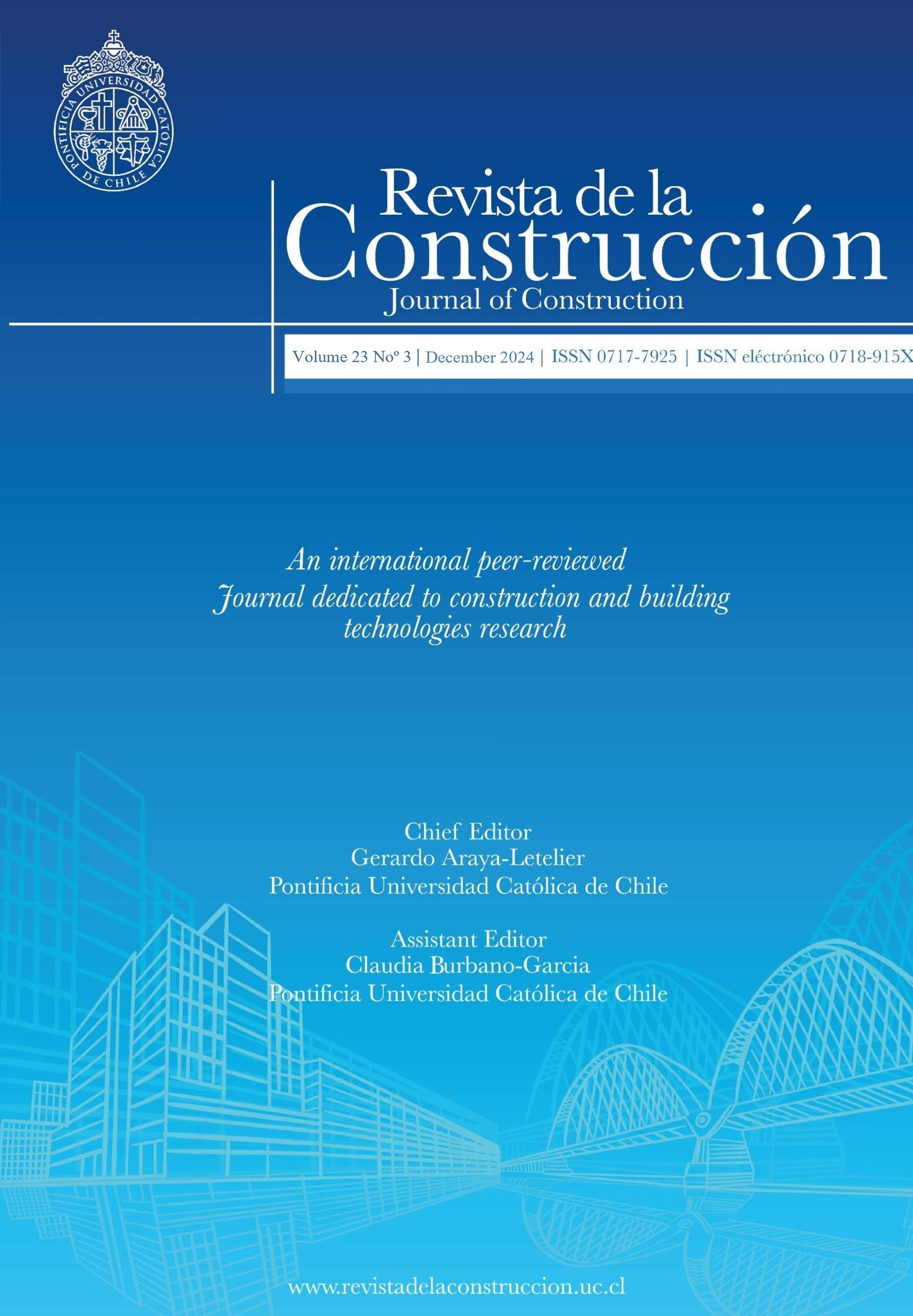Rheological behaviour of cement mortar with recycled organic sand
DOI:
https://doi.org/10.7764/RDLC.23.3.639Keywords:
ROS Sand, fresh properties, rheology, Bingham model, segregation.Abstract
The aim of this paper is the study of rheological behaviour of the recycled organic sand (ROS) in cement mortar, using derived sand from recycled asphalt pavement (RAP). Four substitutions amount of ROS sands (25%, 50%, 75%, and 100%) against the weight of natural sand (NS) were used to obtain M 25, M 50, M 75, and M 100 respectively which were compared with the reference mortar M 0. In this study, the water/cement (w/c) ratio was kept constant at 0.55 for all mixtures. Fresh properties were given form slump test and spread measurements, when, the rheological parameters such as shear stress, yield stress and plastic viscosity were obtained by using a rotating Anton Paar rheometer; the test result shows that both of slump and spread were negatively affected by increasing the sand substitution. The shear stress, yield stress and plastic viscosity were increased with the increasing the substitution amount. All mortars followed the Bingham model until 50% of ROS substitution, after this amount, the obtained mortars were segregated.
Downloads
References
Artelt, C., and Garcia, E. (2008). Impact of superplasticizer concentration and of ultra-fine particles on the rheological behaviour of dense mortar suspen-sions. Cement and Concrete Research, 38(5), 633-642.
Arulmoly, B., Konthesingha, C., and Nanayakkara, A. (2021). Effects of blending manufactured sand and offshore sand on rheological, mechanical and durability characterization of lime-cement masonry mortar. European Journal of Environmental and Civil Engineering, 1-27.
Benabed, B., Azzouz, L., Kadri, E.-H., Kenai, S., and Belaidi, A. S. E. (2014). Effect of fine aggregate replacement with desert dune sand on fresh proper-ties and strength of self-compacting mortars. Journal of Adhesion Science and Technology, 28(21), 2182-2195.
Bizinotto, M. B., Faleschini, F., Fernández, C. G. J., and Hernández, D. F. A. (2017). Effects of chemical admixtures on the rheology of fresh recycled aggregate concretes. Construction and Building Materials, 151, 353-362.
Boisly, M., Kastner, M., Brummund, J., and Ulbricht, V. (2014). General Aspects of Yield Stress Fluids—Terminology and Definition of Viscosity. Appl. Rheol, 24(1), 14578.
Braymand, S., François, P., Feugeas, F., and Fond, C. (2015). Rheological properties of recycled aggregate concrete using superplasticizers. Journal of Civil Engineering and Architecture, 9, 591-597.
Carro-Lopez, D., González-Fonteboa, B., Martínez-Abella, F., González-Taboada, I., de Brito, J., and Varela-Puga, F. (2018). Proportioning, fresh-state properties and rheology of self-compacting concrete with fine recycled aggregates. Hormigón y Acero, 69(286), 213-221.
Castaño-Cardoza, T., Linsel, S., Alujas-Diaz, A., Orozco-Morales, R., and Martirena-Hernández, J. F. (2016). Influence of very fine fraction of mixed recycled aggregates on the mechanical properties and durability of mortars and concretes. Revista Facultad de Ingeniería Universidad de Antio-quia(81), 81-92.
Çelik Sola, Ö., and Ozyazgan, C. (2017). Mechanical properties of mortar containing recycled asphalt. Građevinar, 69(10.), 933-940.
Corinaldesi, V., and Moriconi, G. (2009). Behaviour of cementitious mortars containing different kinds of recycled aggregate. Construction and Building Materials, 23(1), 289-294.
de Oliveira, L. P., Gomes, J. C., and Nepomuceno, M. (2013). The influence of wastes materials on the rheology of rendering mortars. APPLIED RHEOL-OGY, 23(1), 11.
Debieb, F., Courard, L., Kenai, S., and Degeimbre, R. (2010). Mechanical and durability properties of concrete using contaminated recycled aggregates. Cement and Concrete Composites, 32(6), 421-426.
Duan, Z., Hou, S., Xiao, J., and Singh, A. (2020). Rheological properties of mortar containing recycled powders from construction and demolition wastes. Construction and Building Materials, 237, 117622.
Esteves, L. P., Cachim, P., and Ferreira, V. (2010). Effect of fine aggregate on the rheology properties of high performance cement-silica systems. Cons-truction and Building Materials, 24(5), 640-649.
Ezziane, K., and Kadri, E. Effet de la fume de silice sur la rhéologie des mortiers en présence d’un superplastifiant.
Ezziane, K., Ngo, T.-T., and Kaci, A. (2014). Evaluation of rheological parameters of mortar containing various amounts of mineral addition with poly-carboxylate superplasticizer. Construction and Building Materials, 70, 549-559.
Faleschini, F., Jiménez, C., Barra, M., Aponte, D., Vázquez, E., and Pellegrino, C. (2014). Rheology of fresh concretes with recycled aggregates. Construc-tion and Building Materials, 73, 407-416.
González-Fonteboa, B., González-Taboada, I., Carro-López, D., and Martínez-Abella, F. (2021). Influence of the mixing procedure on the fresh state behaviour of recycled mortars. Construction and Building Materials, 299, 124266.
González-Taboada, I., González-Fonteboa, B., Martínez-Abella, F., and Seara-Paz, S. (2017). Analysis of rheological behaviour of self-compacting con-crete made with recycled aggregates. Construction and Building Materials, 157, 18-25.
Güneyisi, E., Gesoglu, M., Algın, Z., and Yazıcı, H. (2016). Rheological and fresh properties of self-compacting concretes containing coarse and fine recycled concrete aggregates. Construction and Building Materials, 113, 622-630.
Guo, Z., Chen, C., Lehman, D. E., Xiao, W., Zheng, S., and Fan, B. (2017). Mechanical and durability behaviours of concrete made with recycled coarse and fine aggregates. European Journal of Environmental and Civil Engineering, 1-19.
Irki, I., Debieb, F., Ouzadid, S., Dilmi, H. L., Settari, C., and Boukhelkhel, D. (2018). Effect of Blaine fineness of recycling brick powder replacing cementi-tious materials in self compacting mortar. Journal of Adhesion Science and Technology, 32(9), 963-975.
Jiang, J., Zhou, W., Gao, Y., Wang, L., Wang, F., Chu, H.-y., . . . Li, J. (2019). Feasibility of manufacturing ultra-high performance cement-based compo-sites (UHPCCs) with recycled sand: A preliminary study. Waste management, 83, 104-112.
Jiang, D., Li, X., Lv, Y., Zhou, M., He, C., Jiang, W., ... and Li, C. (2020). Utilization of limestone powder and fly ash in blended cement: Rheology, strength and hydration characteristics. Construction and Building Materials, 232, 117228.
Joudi-Bahri, I., Lecomte, A., Ouezdou, M. B., and Achour, T. (2012). Use of limestone sands and fillers in concrete without superplasticizer. Cement and Concrete Composites, 34(6), 771-780.
KESSEIR, M., BOUKENDAKDJI, O., KADRI, E. H., and NGO, T. T. (2020). Rheological and mechanical performance evaluation of high performance mortar based natural pozzolan. Journal of Materials and Engineering Structures «JMES», 7(3), 467-476.
Kumari, M., Ransinchung, G., and Singh, S. (2018). A laboratory investigation on Dense Bituminous Macadam containing different fractions of coarse and fine RAP. Construction and Building Materials, 191, 655-666.
Li, B., Hou, S., Duan, Z., Li, L., and Guo, W. (2021). Rheological behavior and compressive strength of concrete made with recycled fine aggregate of different size range. Construction and Building Materials, 268, 121172.
Li, X. (2009). Recycling and reuse of waste concrete in China: Part II. Structural behaviour of recycled aggregate concrete and engineering applications. Resources, Conservation and recycling, 53(3), 107-112.
Lima, P. R. L., and Leite, M. B. (2012). Influence of CDW recycled aggregate on drying shrinkage of mortar. Open Journal of Civil Engineering, 2(02), 53.
Lima, P. R. L., Leite, M. B., and Santiago, E. Q. R. (2010). Recycled lightweight concrete made from footwear industry waste and CDW. Waste manage-ment, 30(6), 1107-1113.
Lima, P. R. L., Toledo Filho, R. D., and Gomes, O. d. F. M. (2014). Influence of recycled aggregate on the rheological behavior of cement mortar. Paper presented at the Key Engineering Materials.
Miranda, L. F., and Selmo, S. M. (2006). CDW recycled aggregate renderings: Part I–Analysis of the effect of materials finer than 75 μm on mortar prop-erties. Construction and Building Materials, 20(9), 615-624.
Nazar, S., Yang, J., Thomas, B. S., Azim, I., and Rehman, S. K. U. (2020). Rheological properties of cementitious composites with and without nano-materials: A comprehensive review. Journal of Cleaner Production, 272, 122701.
Nehdi, M., Mindess, S., and Aı̈tcin, P.-C. (1998). Rheology of high-performance concrete: effect of ultrafine particles. Cement and Concrete Research, 28(5), 687-697.
Ngo, T.-T., Bouvet, A., Debieb, F., and Aggoun, S. (2017). Effect of cement and admixture on the utilization of recycled aggregates in concrete. Construc-tion and Building Materials, 149, 91-102.
Ren, Q., Tao, Y., Jiang, Z., & De Schutter, G. (2024). Adhesive and rheological properties of fresh mortar with manufactured sand as replacement of river sand. Construction and Building Materials, 411, 134303.
Riccardi, C., Falchetto, A. C., Losa, M., and Wistuba, M. P. (2016). Rheological modeling of asphalt binder and asphalt mortar containing recycled asphalt material. Materials and Structures, 49(10), 4167-4183.
Safiddine, S., Debieb, F., Kadri, E.-H., Menadi, B., and Soualhi, H. (2017). Effect of Crushed Sand and Limestone Crushed Sand Dust on the Rheology of Cement Mortar. APPLIED RHEOLOGY, 27(1).
Safiddine, S., Amokrane, K., Debieb, F., Soualhi, H., Benabed, B., and Kadri, E. H. (2021). How quarry waste limestone filler affects the rheological be-havior of cement-based materials. Applied Rheology, 31(1), 63-75.
Sahraoui, M., and Bouziani, T. (2019). Effects of fine aggregates types and contents on rheological and fresh properties of SCC. Journal of Building Engineering, 26, 100890.
Schwartzentruber, A., and Catherine, C. (2000). La méthode du mortier de béton équivalent (MBE)—Un nouvel outil d’aide à la formulation des bétons adjuvantés. Materials and Structures, 33(8), 475-482.
Settari, C., Debieb, F., Kadri, E. H., and Boukendakdji, O. (2015). Assessing the effects of recycled asphalt pavement materials on the performance of roller compacted concrete. Construction and Building Materials, 101, 617-621.
Silva, R., De Brito, J., and Dhir, R. (2018). Fresh-state performance of recycled aggregate concrete: A review. Construction and Building Materials, 178, 19-31.
Singh, S., Ransinchung, G., Monu, K., and Kumar, P. (2018). Laboratory investigation of RAP aggregates for dry lean concrete mixes. Construction and Building Materials, 166, 808-816.
Singh, S., Ransinchung RN, G., and Kumar, P. (2017). Laboratory investigation of concrete pavements containing fine RAP aggregates. Journal of Materi-als in Civil Engineering, 30(2), 04017279.
Sola, Ö. Ç., and Ozyazgan, C. (2017). Mechanical properties of mortar containing recycled asphalt. GRADEVINAR, 69(10), 933-940.
Soualhi, H., Kadri, E.-H., Ngo, T.-T., Bouvet, A., Cussigh, F., and Tahar, Z.-E.-A. (2017). Design of portable rheometer with new vane geometry to estimate concrete rheological parameters. Journal of civil engineering and management, 23(3), 347-355.
Soualhi, H., Kadri, E., Ngo, T., Bouvet, A., Cussigh, F., and Kenai, S. (2014). A vane rheometer for fresh mortar: development and validation. Appl. Rheol, 24(2), 1-7.
Tahar, Z. E. A., Kadri, E.-H., Ngo, T.-T., Bouvet, A., Kaci, A., and Aggoun, S. (2015). Etude de l'influence des granulats recyclés sur le comportement des MBE. Paper presented at the Rencontres Universitaires de Génie Civil.
Tekin, K., Keskin, S. B., & Keskin, Ö. K. (2022). Effects of particle size optimization of quartz sand on rheology and ductility of engineered cementitious composites. Revista de la construcción, 21(2), 447-460.
Vázquez, E., Barra, M., Aponte, D., Jiménez, C., and Valls, S. (2014). Improvement of the durability of concrete with recycled aggregates in chloride exposed environment. Construction and Building Materials, 67, 61-67.
Westerholm, M., Lagerblad, B., Silfwerbrand, J., and Forssberg, E. (2008). Influence of fine aggregate characteristics on the rheological properties of mor-tars. Cement and Concrete Composites, 30(4), 274-282.
Downloads
Published
How to Cite
Issue
Section
License
Copyright (c) 2024 Settari Chafika, Irki Ilyes, Debieb Farid, Kadri Elhadj

This work is licensed under a Creative Commons Attribution-NonCommercial-NoDerivatives 4.0 International License.








